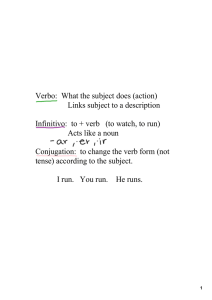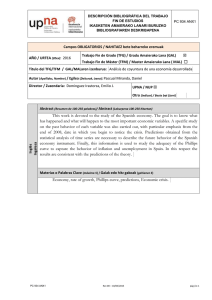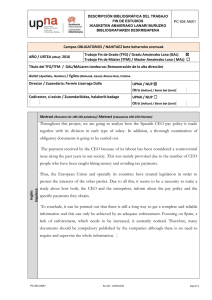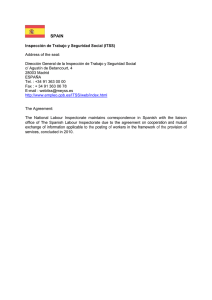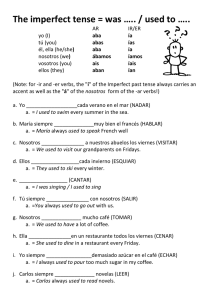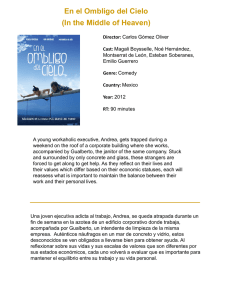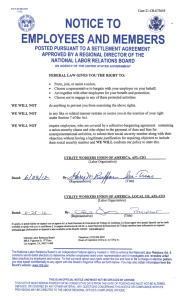Spanish adaptation of the Internal functioning of the
Anuncio
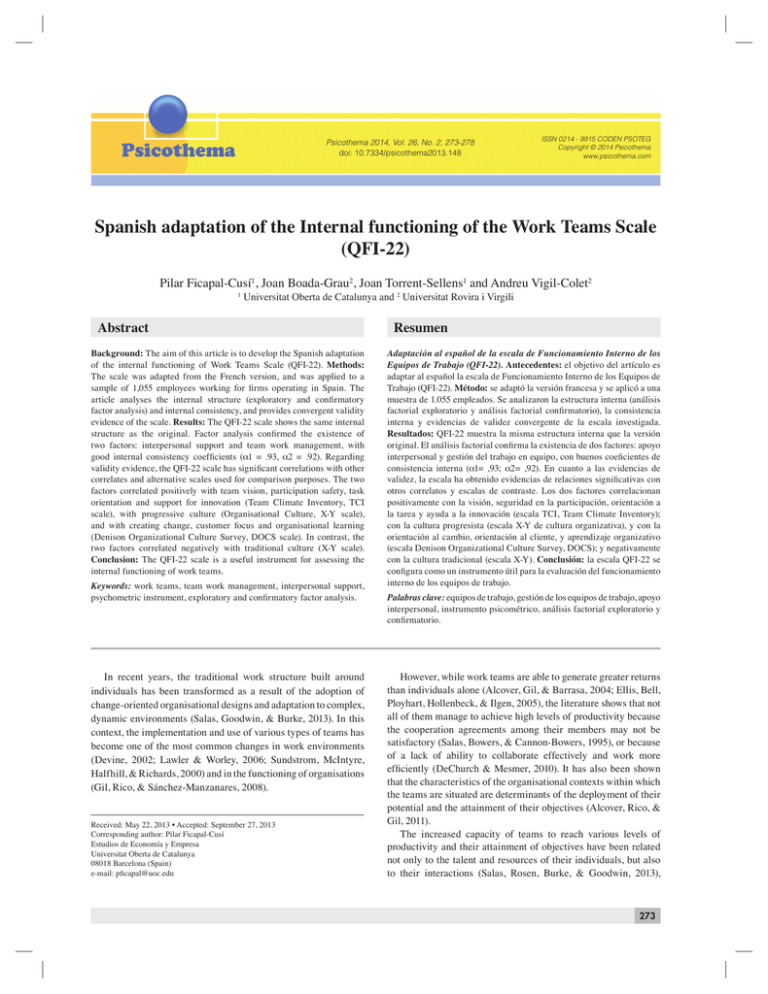
Psicothema 2014, Vol. 26, No. 2, 273-278 doi: 10.7334/psicothema2013.148 ISSN 0214 - 9915 CODEN PSOTEG Copyright © 2014 Psicothema www.psicothema.com Spanish adaptation of the Internal functioning of the Work Teams Scale (QFI-22) Pilar Ficapal-Cusí1, Joan Boada-Grau2, Joan Torrent-Sellens1 and Andreu Vigil-Colet2 1 Universitat Oberta de Catalunya and 2 Universitat Rovira i Virgili Abstract Background: The aim of this article is to develop the Spanish adaptation of the internal functioning of Work Teams Scale (QFI-22). Methods: The scale was adapted from the French version, and was applied to a sample of 1,055 employees working for firms operating in Spain. The article analyses the internal structure (exploratory and confirmatory factor analysis) and internal consistency, and provides convergent validity evidence of the scale. Results: The QFI-22 scale shows the same internal structure as the original. Factor analysis confirmed the existence of two factors: interpersonal support and team work management, with good internal consistency coefficients (α1 = .93, α2 = .92). Regarding validity evidence, the QFI-22 scale has significant correlations with other correlates and alternative scales used for comparison purposes. The two factors correlated positively with team vision, participation safety, task orientation and support for innovation (Team Climate Inventory, TCI scale), with progressive culture (Organisational Culture, X-Y scale), and with creating change, customer focus and organisational learning (Denison Organizational Culture Survey, DOCS scale). In contrast, the two factors correlated negatively with traditional culture (X-Y scale). Conclusion: The QFI-22 scale is a useful instrument for assessing the internal functioning of work teams. Keywords: work teams, team work management, interpersonal support, psychometric instrument, exploratory and confirmatory factor analysis. In recent years, the traditional work structure built around individuals has been transformed as a result of the adoption of change-oriented organisational designs and adaptation to complex, dynamic environments (Salas, Goodwin, & Burke, 2013). In this context, the implementation and use of various types of teams has become one of the most common changes in work environments (Devine, 2002; Lawler & Worley, 2006; Sundstrom, McIntyre, Halfhill, & Richards, 2000) and in the functioning of organisations (Gil, Rico, & Sánchez-Manzanares, 2008). Received: May 22, 2013 • Accepted: September 27, 2013 Corresponding author: Pilar Ficapal-Cusí Estudios de Economía y Empresa Universitat Oberta de Catalunya 08018 Barcelona (Spain) e-mail: [email protected] Resumen Adaptación al español de la escala de Funcionamiento Interno de los Equipos de Trabajo (QFI-22). Antecedentes: el objetivo del artículo es adaptar al español la escala de Funcionamiento Interno de los Equipos de Trabajo (QFI-22). Método: se adaptó la versión francesa y se aplicó a una muestra de 1.055 empleados. Se analizaron la estructura interna (análisis factorial exploratorio y análisis factorial confirmatorio), la consistencia interna y evidencias de validez convergente de la escala investigada. Resultados: QFI-22 muestra la misma estructura interna que la versión original. El análisis factorial confirma la existencia de dos factores: apoyo interpersonal y gestión del trabajo en equipo, con buenos coeficientes de consistencia interna (α1= ,93; α2= ,92). En cuanto a las evidencias de validez, la escala ha obtenido evidencias de relaciones significativas con otros correlatos y escalas de contraste. Los dos factores correlacionan positivamente con la visión, seguridad en la participación, orientación a la tarea y ayuda a la innovación (escala TCI, Team Climate Inventory); con la cultura progresista (escala X-Y de cultura organizativa), y con la orientación al cambio, orientación al cliente, y aprendizaje organizativo (escala Denison Organizational Culture Survey, DOCS); y negativamente con la cultura tradicional (escala X-Y). Conclusión: la escala QFI-22 se configura como un instrumento útil para la evaluación del funcionamiento interno de los equipos de trabajo. Palabras clave: equipos de trabajo, gestión de los equipos de trabajo, apoyo interpersonal, instrumento psicométrico, análisis factorial exploratorio y confirmatorio. However, while work teams are able to generate greater returns than individuals alone (Alcover, Gil, & Barrasa, 2004; Ellis, Bell, Ployhart, Hollenbeck, & Ilgen, 2005), the literature shows that not all of them manage to achieve high levels of productivity because the cooperation agreements among their members may not be satisfactory (Salas, Bowers, & Cannon-Bowers, 1995), or because of a lack of ability to collaborate effectively and work more efficiently (DeChurch & Mesmer, 2010). It has also been shown that the characteristics of the organisational contexts within which the teams are situated are determinants of the deployment of their potential and the attainment of their objectives (Alcover, Rico, & Gil, 2011). The increased capacity of teams to reach various levels of productivity and their attainment of objectives have been related not only to the talent and resources of their individuals, but also to their interactions (Salas, Rosen, Burke, & Goodwin, 2013), 273 Pilar Ficapal-Cusí, Joan Boada-Grau, Joan Torrent-Sellens and Andreu Vigil-Colet which are fundamental to the members’ cognition, language and interdependence (Marks, Mathieu, & Zaccaro, 2001). The behaviour of work teams is conceived as an interaction process, where internal cognition (a shared mental model) and feelings (a feeling of belonging) are transformed into behaviours that will have an influence on the final outcome of the teams (Rousseau, Aubé, & Savoie, 2006; Sheng, Tian, & Chen, 2010). One of the behaviours inherent to the existence of work teams is conduct oriented towards facilitating the fulfilment (or attainment) of common tasks (Salas et al., 1995). However, there is no clear consensus on how to conceptualise and measure behaviours of this type (Humphrey, Karam, & Morgeson, 2010). From the instruments available for studying the functioning of work teams, we have chosen to adapt the multidimensional conception of team behaviour proposed by Rousseau et al. (2006), which they call “the internal functioning of work teams” (QFI). The QFI establishes a set of behaviours adopted by the members of a team (considered as a system and not simply as a group of individuals), whose objective is to facilitate the execution of common tasks. It consists of seven dimensions, which are described below. Cooperation (also called ‘work assistance’, ‘instrumental support’ or ‘collaboration’) means the degree to which the team members voluntarily help each other do their work when necessary (Eby & Dobbins, 1997). Communication (or ‘conveying information’) means the degree to which the team members exchange useful ideas or information at the right time to do their tasks (Janz, Colquitt, & Noe, 1997). Psychological support (also called ‘social support’) (Campion, Medsker, & Higgs, 1993; Gladstein, 1984) means the degree to which the team members express their respect for each other, as well as concerns for their common wellbeing (Edmondson, 1999). Conflict management means the degree to which the team members try to constructively overcome real or potential differences in relation to their preferences, values or interests (Yeatts & Hyten, 1998). Work organisation/planning means the degree to which the team members equip themselves with a work plan detailing each member’s functions and responsibilities, and the methods used to coordinate and complete their activities by the deadlines set (Marks et al., 2001; Weldon, Jehn, & Pradhan, 1991). Resource management means the degree to which the team members optimally use the resources available to the team (Anderson & West, 1996; Weldon et al., 1991). Lastly, support for innovation (also called ‘learning behaviour’ or ‘proactive behaviour’ (Hyatt & Ruddy, 1997) means the degree to which the team members use the means that facilitate the implementation of new practices in their activities (Anderson & West, 1996). The original version of the QFI scale in French has 22 items, which are grouped under two factors (Rousseau et al., 2006). The first factor, namely interpersonal support (α = .93), means the degree to which the team members optimise the quality of their interactions, and consists of elements belonging to the dimensions of cooperation (3 items), communication (2 items), psychological support (3 items) and conflict management (4 items). The second factor, namely team work management (α = .91), means the degree to which the team members structure the execution of their work in relation to work organisation/planning (4 items), resource management (2 items), support for innovation (3 items) and 274 communication (1 item). The employees answered the questions on a 5-point Likert-type scale, where 1= strongly disagree and 5 = strongly agree. The aim of this article is to develop the Spanish adaptation of the QFI scale by translating the items and analysing the internal structure (exploratory and confirmatory factor analysis) and internal consistency, and providing convergent validity evidence of the scale. Method Participants The sample comprised 1,055 employees belonging to 217 work teams working for firms operating in Spain. The mean number of members per team was 4.8 (SD = 0.35). The teams were diverse and their tasks were of different types: administrative, commercial, production, etc. Of the sample, 42.7% was male and 57.3% female. The employees’ mean age was 36.8 years (SD = 9.10), and most of them had started or finished their university-level studies (71.2%). The mean length of service was 6.5 years (SD = 6.33) in their posts and 8.9 years (SD = 9.06) in their firms. The teams belonged to companies whose activities included financial intermediation, education and social services, health and hospitals, commerce, telecommunications, metallurgy and other similar activities, pharmaceuticals, chemicals, security, sales-oriented services, information technology (IT), general consultancy, hotel industry, distribution, tourism and food. The total sample was selected by non-probability sampling (Hernández, Fernández, & Baptista, 2010), otherwise known as random accidental sampling (Kerlinger, 2001). The response rate was 84%. Of the sample, 10% abstained from participating, and a further 6% of the questionnaires returned were rejected due to completion mistakes or omissions. Instruments The instrument was adapted by following the steps shown in the scientific literature for adapting assessment instruments (Brislin, 1970; Hambleton, 1994; Hambleton, Merenda, & Spielberger, 2005; Muñiz & Bartram, 2007; Muñiz, Elosua, & Hambleton, 2013). First, the items were translated from French into Spanish by research experts (university lecturers, for example) and language experts belonging to the Language Service at the University. Second, a focus group was held to discuss the translated items (equivalence of meaning, for example). Third, the language experts back-translated the items into French. Fourth and lastly, the equivalence of meaning of the original and adapted versions was checked. In order to assess validity evidence external to the QFI scale, a further three scales and correlates were analysed. First, the Spanish version of the Team Climate Inventory (TCI-14; Boada-Grau, De Diego, De Llanos, & Vigil-Colet, 2011). This scale is a measure of team climate for innovation (Anderson & West, 1996) and has 14 items and 4 sub-scales: team vision (α = .82), participation safety (α = .82), task orientation (α = .80) and support for innovation (α = .75). It employs a 5-point response scale, where 1 = strongly disagree and 5 = strongly agree. Second, the Organisational Culture scale (Bonavía & Quintanilla, 1996; Bonavía, Molina, & Boada-Grau, 2009). This Spanish adaptation of the Internal functioning of the Work Teams Scale (QFI-22) instrument has 24 items and allows organisations’ X culture (traditional) and Y culture (progressive) to be assessed. The internal consistency of the factors (X and Y) is α = .80. It employs a 6-point Likert-type response scale, where 1 = strongly disagree and 6 = strongly agree. Third, the Denison Organizational Culture Survey (DOCS; Bonavía, Prado, & Barberá, 2009). This scale assesses organisational culture and its influence on organisational effectiveness (Denison, Hart, & Khan, 1996). The Spanish version of the DOCS scale has 60 items grouped under 12 subscales and 4 cultural dimensions. In this study, we have used the Adaptability dimension (α = .87), which has three sub subfactors: Creating Change (α = .78), Customer Focus (α = .78) and Organisational Learning (α = .70). It employs a 5-point Likerttype response scale, where 1 = strongly disagree and 5 = strongly agree. Finally, to complete the convergent validity evidence of the QFI scale, several correlates (Líbano, Llorens, Salanova, & Schaufeli, 2010) or external indicators were used (Gimeno, Benavides, Mira, Martínez, & Benach, 2004). These correlates were: team leadership has tended to be a source of inspiration; team leadership has tended to motivate; team leadership has tended to be results-oriented; our team has been creative; and our team has been productive. Answers to the questions were given on a 5-point Likert-type scale, where 1 = strongly disagree and 5 = strongly agree. Procedure After contacting the employees or work teams selected to take part in the study, the scales were administered individually or collectively in work time with the prior consent of the firms’ managers. The participants were given instructions to enable them to answer the scales. They were also given an assurance about the confidentiality and anonymity of the data obtained. Data analysis The total sample of 1,055 employees was randomly divided into two sub-samples (527 and 528 employees, respectively) in order to obtain evidence of cross-validity. On the first sub-sample, an exploratory factor analysis was performed by applying the principal axis extraction and Promin rotation methods. In this context, polychoric correlation matrices were used; these are particularly suitable for items with a Likert-type response format (Muthen & Kaplan, 1992). The Factor 7.2 program (LorenzoSeva & Ferrando, 2006) was used to perform the exploratory factor analysis. This program allows polychoric correlation matrices to be analysed and procedures such as parallel analysis to be performed, which are unavailable in programs like SPSS. The parallel analysis was performed using the optimal parallel analysis option in Factor 7.2. In performing this analysis, the characteristics of the data were taken into account and the polychoric correlations and random permutations of the answers (Timmerman & Lorenzo-Seva, 2011) were taken as the basis. On the second sub-sample, a confirmatory factor analysis was performed in order to validate the factorial structure obtained from the first sub-sample. The Mplus 5.1 program was used for this purpose, and specifically the maximum likelihood estimation method (Muthen & Muthen, 2008). Results In the exploratory factor analysis, a Kaiser-Meyer-Olkin index of 0.94 was obtained, confirming the adequacy of the matrix for factor analysis. As shown in Figure 1, the scree test (Cattell, 1966) yielded a two-factor solution. Parallel analysis also yielded this two-factor structure (Lattin, Carroll, & Green, 2003). After determining the number of factors to be extracted, the Promin rotation method was used (Lorenzo-Seva, 1999). This method of oblique rotation tends to yield the very simplest of solutions. In this respect, two factors were obtained, with 9 and 13 items, respectively. The total variance explained by these factors was 49.2%. Like the original version in French, the two factors presented a high correlation r = .59 (r = .71 in the original version). Table 1 shows the saturation matrix of the factors obtained from the exploratory factor analysis and the variance explained by each factor. In order to confirm the structure found in the exploratory factor analysis, a confirmatory factor analysis was performed on the second sub-sample, based on a three-dimensional structure hypothesis. The goodness-of-fit indices used to assess the confirmatory factor analysis were the comparative fit index (CFI), the non-normed fit index (NNFI) and the root mean square error of approximation (RMSEA). While there is no absolute consensus, values equal to or higher than 0.9 for the first two are generally considered acceptable. For the RMSEA, a value lower than 0.08 is considered acceptable, and a value equal to or lower than 0.05 is considered excellent (Bentler, 1990; Fan & Sivo, 2007). The results indicated that the model’s goodness-of-fit was acceptable (RMSEA = .06, CFI = .91, and NNFI = .90). Bearing in mind that the original version of the test presented a high correlation between the factors and that, albeit lower, the value in our case could still be considered relatively high, we performed a second confirmatory factor analysis to check for the data’s potential fit in a one-dimensional structure. In this case, the fit was significantly worse than the one obtained for the two-factor solution (Δχ2 = 309, p<.001), and all the fit indices were outside acceptable limits (RMSEA = .095, CFI = .81, NNFI = .786). 50 45 40 35 30 25 20 15 10 5 0 1 2 3 4 5 6 7 8 9 10 11 12 13 14 15 16 17 18 19 Empirical an. Parallel an. Figure 1. Sedimentation graph and parallel analysis of the QFI-22 275 Pilar Ficapal-Cusí, Joan Boada-Grau, Joan Torrent-Sellens and Andreu Vigil-Colet Table 1 QFI-22: Saturation matrix of the factors extracted from the exploratory factor analysis Items 01. Nosotros nos ayudamos entre nosotros para efectuar nuestro trabajo [We help each other do our work] 02. Nosotros planificamos la realización de nuestras actividades de trabajo [We plan the execution of our work activities] 03. Nosotros discutimos abiertamente las desavenencias antes de que se conviertan en conflictos [We openly discuss misunderstandings before they turn into conflicts] 04. Nosotros nos tomamos el tiempo necesario parar desarrollar nuevas maneras de hacer nuestro trabajo [We take time to develop new ways of doing our work] 05. Nosotros nos alentamos mutuamente parar hacer bien nuestro trabajo [We encourage each other to do our work well] 06. Nosotros establecemos un calendario de trabajo [We set a work schedule] 07. Nosotros facilitamos el trabajo de nuestros compañeros [We make our colleagues’ work easier] 08. Nosotros perseguimos activamente nuevas prácticas que puedan mejorar nuestro trabajo [We actively seek new practices that have the ability to improve our work] 09. Nosotros nos respetamos los unos a los otros [We respect each other] 10. Nosotros organizamos el cumplimiento de nuestras actividades de trabajo [We organise the fulfilment of our work activities] 11. Cuando un conflicto enrarece nuestro trabajo, tratamos de resolverlo [When a conflict harms our work, we seek to resolve it] 12. Nosotros sacamos provecho de las ideas de cada uno para mejorar nuestra manera de trabajar [We take advantage of everyone’s ideas to improve our way of working] 13. Nosotros transmitimos a cada uno de los miembros la información pertinente en el trabajo [We convey information useful for work to each of the members] 14. Nosotros coordinamos el desarrollo de nuestras actividades de trabajo [We coordinate the running of our work activities] 15. Nosotros nos aseguramos de entender el punto de vista de nuestros compañeros [We ensure that we fully understand our colleagues’ points of view] 16. Nosotros sabemos el estado de preparación de nuestro trabajo [We take stock of the state of progress of our work] 17. Nosotros abordamos y administramos abiertamente los conflictos entre los compañeros [We openly deal with and manage conflicts between colleagues] 18. Nosotros evaluamos los resultados de nuestro trabajo [We assess the results of our work] 19. Nosotros nos mostramos sensibles a los sentimientos y al bienestar de nuestros compañeros [We are empathetic to our colleagues’ feelings and wellbeing] 20. Nosotros ponemos en práctica nuevas maneras de hacer nuestro trabajo [We put new ways of doing our work into practice] 21. Nosotros respetamos el punto de vista de cada uno incluso si no somos de la misma opinión [We respect everyone’s point of view, even if we do not share it] 22. Nosotros discutimos sobre los desacuerdos de forma franca y sincera [We discuss misunderstandings in a frank, sincere manner] F1 F2 -0.03 -0.75 -0.13 -0.48 -0.15 -0.78 -0.18 -0.51 -0.18 -0.61 -0.15 -0.14 -0.18 -0.73 -0.00 -0.41 -0.00 -0.69 -0.15 -0.42 -0.13 -0.00 -0.63 -0.12 -0.53 -0.20 -0.58 -0.15 -0.56 -0.16 -0.74 -0.02 -0.59 -0.60 -0.48 -0.00 -0.70 -0.27 -0.65 -0.10 -0.86 -0.28 -0.76 -0.66 (F1) Team work management and (F2) Interpersonal support Table 2 QFI-22: Descriptive statistics, internal consistency, confidence intervals, external correlates, alternative scales used for comparison purposes (TCI, X-Y and DOCS) and correlations between the two factors N = 527 M SD Internal consistency Confidence interval Team members Team leadership has tended to be a source of inspiration Team leadership has tended to motivate Team leadership has tended to be results-oriented Our team has been creative Our team has been productive Team vision (TCI) Participation safety (TCI) Task orientation (TCI) Support for innovation (TCI) Culture-Traditional (X-Y) Culture-Progressive (X-Y) Creating change (DOCS) Customer focus (DOCS) Organisational learning (DOCS) F1 F2 N = 528 F1 F2 F1 F2 36.08 6.93 0.86 0.84-0.88 0.00 0.41** 44.97 8.36 0.90 0.89-0.91 0.06* 0.40** 36.24 7.09 0.86 0.85-0.88 0.01 0.46** 44.65 8.9 0.90 0.88-0.91 0.07* 0.52** 0.43** 0.39** 0.46** 0.51** 0.38** 0.34** 0.29** 0.29** 0.52** 0.36** 0.52** 0.53** 0.58** 0.62** -0.26** 0.41** 0.47** 0.41** 0.55** – 0.59 0.45** 0.44** 0.58** 0.77** 0.63** 0.59** -0.26** 0.45** 0.50** 0.30** 0.51** – – 0.47** 0.40** 0.55** 0.59** 0.56** 0.69** -0.36** 0.42** 0.38** 0.35** 0.45** – 0.61 0.46** 0.37** 0.47** 0.76** 0.57** 0.61** -0.32** 0.40** 0.40** 0.20** 0.39** – – ** p<0.01; * p<0.05 (F1) Team work management and (F2) Interpersonal support. Validity: Application of Fisher’s z transformation (at 1%) between the two sub-samples. There are no significant differences; the validity evidence is therefore stable 276 Table 2 shows the descriptive statistics, the internal consistency of the QFI scale and convergent validity evidence with other scales and constructs. In this respect, the first factor – team work management – and the second factor – interpersonal support – correlated positively with team vision, participation safety, task orientation and support for innovation (TCI), progressive culture (X-Y), creating change, customer focus and organisational learning (DOCS), as well as with other correlates relating to team leadership, creativity and results. Finally, the two factors of the QFI scale correlated negatively with traditional culture (X-Y). Discussion This article presented the psychometric properties of the QFI22 scale, an instrument that allows the internal functioning of work teams to be assessed by means of two factors: team work management and interpersonal support. The results confirmed that the scale analysed had a two-factor internal structure and a satisfactory internal consistency, and also provided satisfactory validity evidence. This instrument was empirically validated and had satisfactory psychometric properties. The exploratory factor analysis results indicated the existence of two factors, as in the original version of the scale. Those factors were subsequently confirmed in the confirmatory factor analysis. The first factor comprised 9 items (numbers 2, 4, 6, 8, 10, 14, 16, 18 and 20) and assessed team work management. In addition, it was defined as the degree to which the team members structured the execution of their work in relation to work organisation, planning, new team practices and progression in their work. Conceptually, this factor included work organisation/planning, resource management, support for innovation and communication. The internal consistency of this factor was α = .86, with a confidence interval between α = .84 and α = .88. The second factor comprised 13 items (numbers: 1, 3, 5, 7, 9, 11, 12, 13, 15, 17, 19, 21 and 22) Spanish adaptation of the Internal functioning of the Work Teams Scale (QFI-22) and assessed interpersonal support. It included the cooperation, communication, psychological support and conflict management dimensions. The internal consistency of the second factor was α = .90, with a confidence interval between α = .88 and α = .91. The original version by Rousseau et al. (2006) did not provide convergent validity evidence of the QFI scale. However, Denison et al. (1996) considered that the functioning of a team was related to organisational culture, hence two alternative scales (DOCS and X-Y) referring to this construct were incorporated for comparison purposes. The TCI scale has also been used as an alternative scale for comparison purposes in other studies (Burch & Anderson, 2004). Other authors (Kuipers & Stoker, 2009; Sjøvold, 2006) have associated work teams with other correlates such as creativity, productivity and leadership. It was found that the two factors of the QFI scale – team work management and interpersonal support – correlated positively with team vision, participation safety, task orientation and support for innovation (TCI), progressive culture (X-Y), and creating change, customer focus and organisational learning (DOCS). Similarly, a positive correlation was found for other external correlates connected with team leadership, creativity and results. A positive correlation was also found between the number of team members and interpersonal support. Finally, the two factors of the QFI scale correlated negatively with traditional culture (X-Y). In conclusion, the QFI scale adapted to the Spanish language can be considered useful for assessing the internal functioning of work teams. The various analyses performed have provided evidence of a two-factor structure and have yielded satisfactory statistical indices (Tabachnick & Fidell, 2007). The QFI-22 scale is a short, easy-to-understand instrument that can be quickly applied and interpreted. Regarding its applicability, the two factors of the scale suggest possible interventions that the teams or those responsible for their coordination can make in order to effect a positive impact on their internal functioning. In order to improve their competitive advantages and rapidly respond to market changes, the evidence has shown that organisations must increasingly rely on work team innovation (Tjosvold, Tang, & West, 2004). In this respect, studies on work team performance and innovation have focused on knowledge sharing and on the role of continuing improvement of their effectiveness; in other words, they have emphasised the intra-group interaction process. Furthermore, new organisational contexts based on work team have suggested three types of support that create opportunities for their effectiveness (Rico, Alcover, & Tabernero, 2010). First, human resources management systems. Second, organisational design, allowing work teams to interrelate with each other and with the organisation as a whole. This dimension articulates flows of information, coordination and support, which together facilitate resources and remove obstacles. Third and lastly, the organisational culture and the climate of support for the teams. In keeping with the above, the QFI-22 scale is a useful instrument because it allows training needs to be diagnosed, training policies to be developed, their organisational and management dimension to be analysed, work team productivity to be fostered and performance to be assessed (Salas, Burke, Fowlkes, & Priest, 2004). The limitations of this study are the starting point for research that we intend to conduct in the future. Basically, three lines of future research have been identified. First, it would be timely to analyse the functioning of the scale and the discriminant validity in different groups of employees. A non-exhaustive list might include residents versus immigrants, trained employees versus untrained employees, men versus women and younger people versus older people because these characteristics have the potential to explain significant differences in the functioning of work teams. Second, the QFI-22 scale could be tested in other samples of work teams in order to analyse the correlations between other dimensions of interest such as employment or task result variables, other group phenomena such as cohesion, self-efficacy and job quality, and attitudes such as satisfaction or commitment. Third and lastly, it should be noted that the adaptation of an instrument is a dynamic process that does not end with its publication. In this respect, new studies providing new data and highlighting the need for further expansion and/or comparison will no doubt emerge. Acknowledgments The authors would like to thank Vincent Rousseau from the University of Montreal, Canada, for his kindness and cooperation in sending the original questionnaire of the scale on the internal functioning of work teams. References Alcover, C.Mª, Gil, F., & Barrasa, A. (2004). Aprendizaje de equipo: adaptación en una muestra española de las escalas de actividades de aprendizaje [Team learning: Adaptation of learning activities scales in a Spanish sample]. Psicothema, 16, 378-383. Alcover, C.Mª, Rico, R., & Gil, F. (2011). Equipos de trabajo en contextos organizacionales; dinámicas de cambio, adaptación y aprendizaje en entornos flexibles [Team working in organizational settings, dynamics of change, adaptation and flexible learning environments]. Papeles del Psicólogo, 32, 7-16. Anderson, N.R., & West M.A. (1996). The Team Climate Inventory: Development of the TCI and its applications in teambuilding for innovativeness. European Journal of Work and Organizational Psychology, 5, 53-66. Bentler, P.M. (1990). Comparative fit indices in structural models. Psychological Bulletin, 107, 238-246. Boada-Grau, J., De-Diego, R., De Llanos-Serra, E., & Vigil-Colet, A. (2011). Short Spanish version of Team Climate Inventory (TCI-14): Development and psychometric properties. Psicothema, 23, 308313. Bonavía, T., & Quintanilla, I. (1996). La cultura en las organizaciones y sus efectos sobre la participación de los empleados [The culture in organizations and its impact on employee participation]. Revista de Psicología del Trabajo y de las Organizaciones, 12, 7-26. Bonavía, T., Molina, J.G., & Boada-Grau, J. (2009). Further Examination of the Organizational Culture Scale focused on Artifacts. Psychological Reports, 105, 827-834. Bonavía, T., Prado-Gasco, V.J., & Barberá-Tomás, D. (2009). Adaptación al castellano y estructura factorial del Denison Organizational Culture Survey [Spanish adaptation and factor structure of the Denison Organizational Culture Survey]. Psicothema, 21, 633-638. 277 Pilar Ficapal-Cusí, Joan Boada-Grau, Joan Torrent-Sellens and Andreu Vigil-Colet Brislin, R.W. (1970). Back-translation for cross-cultural research. Journal of Cross-Cultural Psychology, 1, 185-216. Burch, G.J., & Anderson, N. (2004). Measuring person-team fit: Development and validation of the team selection inventory. Journal of Managerial Psychology, 19, 406-426. Campion M.A., Medsker, G.J., & Higgs C.A. (1993). Relations between Workgroup Characteristics and Effectiveness: Implications for Designing Effective Work Groups. Personnel Psychology, 46, 823850. Cattell, R.B. (1966). The scree test for the number of factors. Multivariate Behavioral Research, 1, 245-276. DeChurch, L.A., & Mesmer-Magnus, J.R. (2010). The cognitive underpinnings of team effectiveness: A meta-analysis. Journal of Applied Psychology, 95, 32-53. Denison, D.R. Hart, S.L., & Kahn, J.A. (1996). From chimneys to crossfunctional teams: Developing and validating a diagnostic model. Academy of Management Journal, 39, 1005-1023. Devine, D.J. (2002). A review and integration of classification systems relevant to teams in organizations. Group Dynamics: Theory, Research, and Practice, 6, 291-310. Eby, L.T., & Dobbins G.H. (1997). Collectivistic orientation in teams: An individual and group-level analysis. Journal of Organizational Behavior, 18, 275-295. Edmondson, A.C. (1999). Psychological safety and learning behaviors in work teams. Administrative Science Quarterly, 44, 350-383. Ellis, A., Bell, B., Ployhart, R., Hollenbeck, J., & Ilgen, D. (2005). An evaluation of generic teamwork skills training with action teams: Effects on cognitive and skill-based outcomes. Personnel Psychology, 58, 641-672. Fan, X., & Sivo, S.A. (2007). Sensitivity of fit indices to model misspecification and model types. Multivariate Behavioral Research, 42, 509-529. Gil, F., Rico, R., & Sánchez-Manzanares, M. (2008). Eficacia de equipos de trabajo [Effectiveness of work teams]. Papeles del Psicólogo, 29, 25-31. Gimeno, D., Benavides, F.G., Mira, M., Martínez, J.M., & Benach, J. (2004). External Validation of Psychological Jobs Demands in a Bus Drives Sample. Journal of Occupational Health, 26, 43-48. Gladstein, D.L. (1984). Groups in context: A model of task group effectiveness. Administrative Science Quarterly, 29, 499-517. Hambleton, R.K. (1994). Guidelines for adapting educational and psychological tests: A progress report. European Journal of Psychological Assessment, 10, 229-244. Hambleton, R.K., Merenda, P.F., & Spielberger, C.D. (2005). Adapting educational and psychological tests for cross-cultural assessment. London: Lawrence Erlbaum Associates. Hernández, R., Fernández, C., & Baptista, P. (2010). Metodología de la investigación [Research metodology]. México: McGraw Hill. Humphrey, S.E., Karam, E.P., & Morgeson, F.P. (2010). Towards a typology of team effectiveness: A meta-analytic review. 25th Annual Meeting of the society for industrial and Organizational Psychology, Atlanta, GA. Hyatt, D.E., & Ruddy, T.M. (1997). An examination of the relationship between work group characteristics and performance: Once more into the breach. Personnel Psychology, 50, 553-585. Janz, B.D., Colquitt, J.A., & Noe, R.A. (1997). Knowledge worker team effectiveness: The role of autonomy, interdependence, team development and contextual support variables. Personnel Psychology, 50, 877-904. Kerlinger, F.N. (2001). Investigación del comportamiento: métodos de investigación en Ciencias Sociales [Research of behavior: Research methods in Social Sciences]. México: McGraw-Hill. Kuipers, B.S., & Stoker, J.I. (2009). Development and performance of self-managing work teams: A theoretical and empirical examination. The International Journal of Human Resource Management, 20, 399-419. Lattin, J., Carroll, D.J., & Green, P.E. (2003). Analyzing multivariate data. Pacific Grove, CA: Duxbury Press. 278 Lawler, E., & Worley, C. (2006). Built to change. How to achieve sustained organizational effectiveness. San Francisco, CA: Jossey-Bass. Líbano, M., Llorens, S., Salanova, M., & Schaufeli, W. (2010). Validity of a brief workaholism scale. Psicothema, 22, 143-150. Lorenzo-Seva, U. (1999). Promin: A method for oblique factor rotation. Multivariate Behavioral Research, 34, 347-365. Lorenzo-Seva, U., & Ferrando, P.J. (2006). FACTOR: A computer program to fit the exploratory factor analysis model. Behavioral Research Methods, Instruments and Computers, 38, 88-91. Marks, M.A., Mathieu, J.E., & Zaccaro, S.J. (2001). A temporally based framework and taxonomy of team processes. Academy of Management Review, 26, 356-376. Muñiz, J., & Bartram, D. (2007). Improving international tests and testing. European Psychologist, 12, 206-219. Muñiz, J., Elosua, P., & Hambleton, R.K. (2013). Directrices para la traducción y adaptación de los tests: segunda edición [International Test Commission Guidelines for test translation and adaptation: Second edition]. Psicothema, 25, 151-157. Muthen, B., & Kaplan, D. (1992). A comparison of some methodologies for the factor analysis of non-normal Likert variables: A note on the size of the model. British Journal of Mathematical and Statistical Psychology, 45, 19-30. Muthen, L.K., & Muthen, B.O. (2008). Mplus (Version 5.1). Los Angeles, CA: Muthen & Muthen. Rico, R., Alcover, C.M., & Tabernero, C. (2010). Efectividad de los equipos de trabajo: una revisión de la última década de investigación (1999-2009) [Effectiveness of work teams: A review of last decade of research (1999-2009)]. Revista de Psicología del Trabajo y de las Organizaciones, 26, 47-71. Rousseau, V., Aubé, C., & Savoie, A. (2006). Le fonctionnement interne des équipes de travail: conception et mesure [The internal functioning of work teams: Design and measurement]. Canadian Journal of Behavioural Science, 38, 120-135. Salas, E., Bowers, C.A., & Cannon-Bowers, J.A. (1995). Military team research: 10 years of progress. Military Psychology, 7, 55-75. Salas, E., Burke, C.S., Fowlkes, J.E., & Priest, H.A. (2004). On measuring teamwork skills. In J.C. Thomas (Ed.), Comprehensive handbook of psychological assessment. New York: John Wiley & Sons. Salas, E., Goodwin G.F., & Burke C.S. (2013). Team effectiveness in complex organizations: Cross-disciplinary perspectives and approaches. New York: Taylor and Francis. Salas, E., Rosen, M.A., Burke, C.S., & Goodwin, G.F. (2013). The wisdom of collectives in organizations: An update of the teamwork competencies. In E. Salas, G.F. Goodwin & C.S. Burke (Eds.), Team effectiveness in complex organizations: Crossdisciplinary perspectives and approaches (pp. 39-79). New York: Taylor and Francis. Sheng, C.W., Tian, Y.F., & Chen, M.C. (2010). Relationships among teamwork behavior, trust, perceived team support, and team commitment. Social Behavior and Personality, 38(10), 1297-1307. Sjøvold, E. (2006). Maturity and effectiveness in small groups. Nordic Psychology, 58, 43-56. Sundstrom, E., McIntyre, M., Halfhill, T., & Richards, H. (2000). Work groups: From the Hawthorne Studies to the work teams of the 1990s. Group Dynamics, 4, 44-67. Tabachnick, B.G., & Fidell, L.S. (2007). Using Multivariate Statistic. Boston: Allyn and Bacon. Timmerman, M.E., & Lorenzo-Seva, U. (2011). Dimensionality assessment of ordered polytomous items with parallel analysis. Psychological Methods, 16, 209-220. Tjosvold, D., Tang, M.M.L., & West, M.A. (2004). Reflexivity for team innovation in China: The contribution of goal interdependence. Group and Organization Management, 29(5), 540-559. Weldon, E., Jehn, K.A., & Pradhan, P. (1991). Processes that mediate the relationship between a group goal and improved group performance. Journal of Personality and Social Psychology, 61, 555-569. Yeatts, D.E., & Hyten, C. (1998). High performing self-managed work teams: A comparison of theory to practice. Thousand Oaks, CA: Sage.

